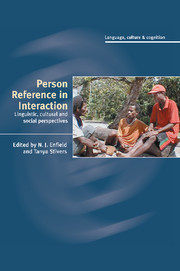Book contents
- Frontmatter
- Contents
- List of contributors
- Preface
- Acknowledgements
- 1 Person reference in interaction
- Part I Person reference as a system
- Part II The person reference system in operation
- Part III The person reference as a system in trouble
- 11 Intersubjectivity and progressivity in person (and place) reference
- 12 Repairing person reference in a small Caribbean community
- 13 Reference and ‘référence dangereuse’ to persons in Kilivila: an overview and a case study
- References
- Index
13 - Reference and ‘référence dangereuse’ to persons in Kilivila: an overview and a case study
Published online by Cambridge University Press: 22 September 2009
- Frontmatter
- Contents
- List of contributors
- Preface
- Acknowledgements
- 1 Person reference in interaction
- Part I Person reference as a system
- Part II The person reference system in operation
- Part III The person reference as a system in trouble
- 11 Intersubjectivity and progressivity in person (and place) reference
- 12 Repairing person reference in a small Caribbean community
- 13 Reference and ‘référence dangereuse’ to persons in Kilivila: an overview and a case study
- References
- Index
Summary
Gräfin: Den Namen! Nur kurz.
Baron: Mit dem Namen anzufangen, würden wir erst in unendliche Umschweife geraten
J. W. GoetheIntroduction
This chapter presents an analysis and case study of the system of person reference in Kilivila, the Austronesian language of the Trobriand Islanders of Papua New Guinea. First, based on conversation analysts' insights into forms of third-person reference mainly in English (Sacks and Schegloff 1979, this volume, Schegloff 1996a), this chapter presents the inventory of forms that Kilivila offers its speakers for making such references. To illustrate in more detail, a case study on gossiping is presented in the second part of the chapter. In the example analysed, ambiguous anaphoric references to two initial mentions of third persons turn out not only to exceed and even violate the frame of a clearly defined situational-intentional variety of Kilivila that is constituted by the genre ‘gossip’, but also are extremely dangerous for speakers in the Trobriand Islanders' society. I illustrate how this culturally dangerous situation escalates and how other participants of the group of gossiping men try to repair this violation of the frame of a culturally defined and metalinguistically labelled ‘way of speaking’ (see Sherzer 1983). The chapter ends with some general remarks on how the understanding of forms of person reference in a language is dependent on the culture specific context in which those forms are produced.
- Type
- Chapter
- Information
- Person Reference in InteractionLinguistic, Cultural and Social Perspectives, pp. 309 - 337Publisher: Cambridge University PressPrint publication year: 2007
- 2
- Cited by



